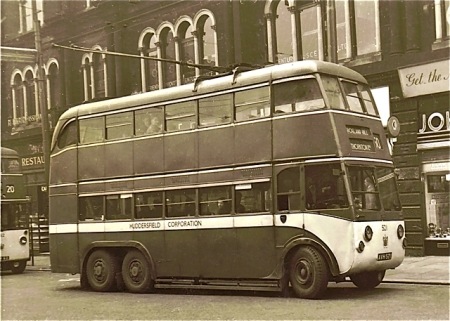Huddersfield Corporation
1940
Karrier E6
Weymann H34/30R
One of the large group of Karrier E6 trolleybuses built to a similar style to the larger group of Park Royal trolleybuses to the unique design specified by Huddersfield. These ten Weymann built bodies were longer than the Park Royal ones and 521 also had English Electric motors and control equipment whereas the majority of the Karrier E6s had Metro-Vickers motors and equipment.
521 is seen in John William Street in Huddersfield on a cross-town route 60 from Birkby to Crosland Hill. This route had a steep hill section of Blackmoorfoot Road requiring the use of the coasting and run-back brake system, a statutory system laid down by the Ministry of Transport.
All Huddersfield trolleybuses from 431 to 640 were fitted with these special brakes, as there were several other routes with steep hills where Ministry Rules applied. The earlier trolleybuses 401 to 430 (1933/34) were not equipped with these coasting and run-back brakes and restricted to the flatter routes, which was possibly an understatement for Huddersfield as nearly every main road appears to have a slope. Huddersfield was the perfect town for trolleybuses but sadly all had gone by the 13 July 1968.
Photograph and Copy contributed by Richard Fieldhouse
21/11/11 – 09:27
I only ever rode on a Huddersfield trolleybus once and I had the impression it was geared. This was in the mid fifties. Could this be possible?
Jim Hepburn
21/11/11 – 11:29
I was always fascinated by this batch of Huddersfield E6s due to their longer front overhang and more “bulbous” fronts, due, I believe, to a mistake when the first dimensional measurements were taken.
Also, when Weymann were building to a design other than their own, a rare event in itself, there was usually some Weymann give away. Derby, for example, had an earlier batch of Guy BTXs with Weymann bodies to the usual Brush style, but they still had the standard Weymann shape of upper rear emergency window.
As Richard says, this batch had EEC equipment, this being replaced after the rebuilding and rebodying process by standard MV units (as far as rebuilding of this batch was concerned).
Absolutely superb trolleybuses, full of character, and a wonderfully nostalgic photograph.
As a Bradfordian, there was something truly atmospheric about the Huddersfield fleet, as it was so different to our own, but that is the magic of our interest is it not….the wide variations in “flavour” given off by different fleets: so different to the drab uniformity of the post 1970 period!
John Whitaker
21/11/11 – 13:15
…..too true, John.
David Oldfield
22/11/11 – 07:30
Jim,
Huddersfield’s Trolleybuses, and I would imagine all other trolleybuses weren’t geared. Assuming, from what you say you only rode on a Huddersfield Trolley once, that you weren’t familiar with trolleybuses in general I think what you would have experienced would have been the superb acceleration qualities of electrically propelled vehicle working up through the ‘notches’ under full power up one of the many steep hills on the Huddersfield system. Bradford was also endowed with similar hilly trolleybus routes. Indeed, when most of the hillier routes in Huddersfield were converted to diesel operation the timetable had to be adjusted to allow for the slower hill climbing abilities of the diesels.
The only other thing I can think of is that you experienced engagement of the coasting brake when descending a steep hill. This was a Ministry of Transport requirement whereby on certain sections of trolleybus route involving decent of steep hills the driver was required to engage the coasting brake by means of a lever in the cab between certain points on said decent and the speed of the trolley was held to around 15mph
Eric
22/11/11 – 07:31
When I was a youngster trying to make sense of the bus world all by myself (thinking I was the only bus nut in the universe), upper deck rear emergency windows were something I always noted the shape of. This grounding later proved invaluable in identifying body makes when the overall design was unfamiliar or deceptive, and became a godsend when visiting Nottingham, where Atlanteans and Fleetlines were built to a standard design by several builders. Now, when preserved buses are lined up at a rally, I still like to go round the back of the line and look up fondly at those telltale windows.
Peter Williamson
22/11/11 – 12:19
Coasting Brake Regulations were applied in Huddersfield on the following routes : –
Newsome South – Newsome Hill section.
Riddings – Woodhouse Hill section.
Crosland Hill – Blackmoorfoot Road section.
Longwood – Paddock Head and Quarmby Clough sections (relaxed 1949).
West Vale & Elland – The Ainleys section.
The steepest section on the Huddersfield system was Woodhouse Hill with a gradient of 1 in 8.9 and these regulations lasted in the Town until the closure of the Newsome and Riddings routes in July 1966.
I hope this might stir some memories for some who may have ridden on these routes and experienced the “groaning” descent of one of the hills on these routes. West Vale however was closed in 1961 and Crosland Hill in 1964 to be replaced by motor buses which were much slower.
Richard Fieldhouse
22/11/11 – 16:03
I wonder why the Quarmby Clough and Paddock Head sections of the Longwood route were included in Coasting Brake regulations. I would have thought the descent from Longwood terminus (the famous turntable) through the village would have been steeper, it was certainly narrow, and has often been quoted as the reason all Huddersfield’s trolley’s were 7’6″ wide.
Whilst on the subject of motor buses being slower Halifax JOC are supposed to have had some AEC Regents specially fitted with petrol engines to try and compete with Huddersfield’s trolleybuses on the climb up The Ainleys from Elland towards Huddersfield. As far as I know they still couldn’t keep up with the trolley’s and just about doubled fuel consumption into the bargain!
Eric

Leave a Reply